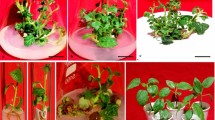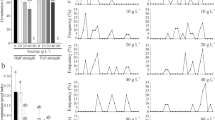Abstract
Leafless nodal segments (4 ± 1 mm long) of hardy hibiscus were excised from in vitro proliferating microshoots, encapsulated in sodium alginate solidified with 50 µM CaCl2, stored under refrigeration for 4 weeks in darkness, and then planted in the greenhouse. Planting in vermiculite and placing under intermittent mist was the best environment tested. If the encapsulated nodal segments were exposed to light for at least 2 weeks while in vitro in the laboratory prior to planting in the greenhouse, all survived, rooted, and produced shoots in the greenhouse. Rooting into the vermiculite was best if the encapsulated nodal segments were planted 1 cm deep and not covered. Anatomically, the new leaves that were produced from shoots that grew under mist in the greenhouse from encapsulated nodal segments were about the same thickness as leaves produced in vitro; had fewer intercellular spaces than the in vitro produced leaves; had palisade cells intermediate in length, and were intermediate for epicuticular wax formation between in vitro produced leaves and leaves on macrocuttings rooted in the greenhouse. The stomates on greenhouse shoots from encapsulated nodal segments closed similar to stomates on leaves on rooted macrocuttings, and were unlike in vitro produced leaves where the stomates remained open even when stressed. Storing and planting encapsulated nodal segments could allow producers to generate sufficient numbers of nodal segments, refrigerate them until needed, and facilitate greenhouse acclimatization and production of plants.
Similar content being viewed by others
References
Bapat VA, Rao PS (1990) In vivo growth of encapsulated axillary buds of mulber4ry (Morus indica L.). Plant Cell Tiss Org Cult 20:69–70
Brainerd KE, Fuchigami LH (1982) Stomatal functioning of in vitro and greenhouse apple leaves in darkness, mannitol, ABA, and CO2. J Exp Bot 33:388–392
Brainerd KE, Fuchigami LH, Kwiatkowski S, Clark CS (1981) Leaf anatomy and water stress of aseptically cultured ‘Pixy’ plum grown under different environments. HortScience 16:173–175
Correll MJ, Weathers PJ (2001) Effects of light, CO2 and humidity on carnation growth, hydperhydration and cuticular wax development in a mist reactor. In Vitro Cell Dev Biol Plant 37:405–413
Donnelly DJ, Vidaver WE (1984) Leaf anatomy of red raspberry transferred from culture to soil. J Amer Soc Hort Sci 109:172–176
Driver JA, Kuniyuki AH (1984) In vitro propagation of paradox walnut rootstock. HortScience 19:507–509
Flore JA, Bukovac MJ (1974) Pesticide effects on the plant cuticle. I. response of Brassica oleracea L. to EPTC as indexed by epicuticular wax production. J Amer Soc Hort Sci 99(1):34–37
Lee N, Wetzstein HY, Sommer HE (1988) Quantum flux density effects on the anatomy and surface morphology of in vitro and in vivo developed Sweetgum leaves. J Amer Soc Hort Sci 113(6):167–171
Pospisilova J, Ticha I, Kadlecek P, Haisel D, Plzakova S (1999) Acclimatization of micropropagated plants to ex vitro conditions. Biol Plant 42:481–497
Preece JE, Sutter EG (1991) Acclimatization of micropropagated plants to the greenhouse and field. In: Debergh P, Zimmerman RH (eds) Micropropagation. Kluwer, Dordrecht, The Netherlands, pp. 71–93
Refouvelet E, Le Nours S, Tallon C, Daguin F (1998) A new method for in vitro propagation of lilac (Syringa vulgaris L.): regrowth and storage conditions for axillary buds encapsulated in alginate beads, development of a pre-acclimatisation stage. Sci Hort 74:233–241
Sarkar D, Naik PS (1998) Synseeds in potato: an investigation using nutrient-encapsulated in vitro nodal segments. Sci Hort 73:179–184
Sampson J (1961) A method of replicating dry or moist surfaces for examination by light microscopy. Nature 191:932–933
SAS Institute Inc. (1999) SAS proprietary software Version 8. SAS Institute Cary, NC
Spurlock BO, Skinner MS, Kattine AA (1966) A simple rapid method for staining epoxy embedded specimens for light microscopy with the polychromatic stain paragon-1301. Am J Clin Pathol 46:252–258
Spurr AR (1969) A low-viscosity epoxy resin embedding medium for electron microscopy. J Ultrstruct Res 26:31–32
Steel RGD, Torrie JH (1980) Principles and procedures of statistics. A biometrical approach. 2nd edn. McGraw-Hill, New York
Sutter E, Langhans RW (1982) Formation of epicuticular wax and its effect on water loss in cabbage plants regenerated from shoot-tip culture. Can J Bot 60:2896–2902
West T, Preece JE (2004) Effects of thidiazuron and nutrient salt formulations on micropropagation of hardy hibiscus (Hibiscus moscheutos L.). Acta Hort 630:293–297
Zaid A, Hughes H (1995) In vitro acclimatization of date palm (Phoenix dactylifera L.) plantlets: a quantitative comparison of epicuticular wax as a function of polyethylene glycol treatment. Plant Cell Rep 15:111–114
Author information
Authors and Affiliations
Corresponding author
Rights and permissions
About this article
Cite this article
Preece, J.E., West, T.P. Greenhouse growth and acclimatization of encapsulated Hibiscus moscheutos nodal segments. Plant Cell Tiss Organ Cult 87, 127–138 (2006). https://doi.org/10.1007/s11240-006-9146-7
Received:
Accepted:
Published:
Issue Date:
DOI: https://doi.org/10.1007/s11240-006-9146-7




